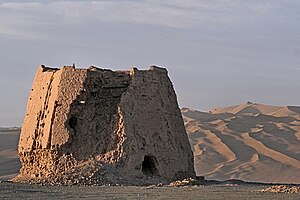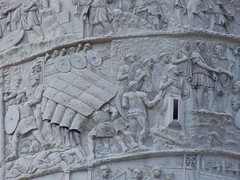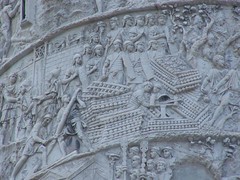The genetic tests have lent weight to the theory that Roman legionaries settled in the area in the first century BC after fleeing a battle. The clash took place in 53BC between an army led by Marcus Crassus, a Roman general, and a larger force of Parthians, from what is now Iran, bringing to an abrupt halt the Roman Empire's eastwards expansion.
Image via Wikipedia
Roman Triumvir Marcus Licinius Crassus
Thousands of Romans were slaughtered and Crassus beheaded, but some were said to have fled east. They supposedly fought as mercenaries in a war between the Huns and the Chinese in 36BC - Chinese chroniclers referred to the capture of a "fish-scale formation" of troops, a possible reference to the "tortoise" phalanx formation perfected by legionaries. The theory was first put forward in the 1950s by Homer Dubs, a professor of Chinese history at Oxford University. But some experts believe the villagers could be descended from the armies of Huns that marauded through Central Asia, which included soldiers of Caucasian origin. - Montreal Gazette
In his paper, A Roman City in Ancient China, Oxford sinologist Homer H.Dubs pointed out that Li-qian was one of only three cities out of 1,587 cities chronicled in the cadastral register in A.D. 5 that was identified with a foreign name. He went on to suggest that the name was a transliteration of an ancient name used to represent the Roman Empire. He also found a statement in the History of the Later Han Dynasty as well as several other historical documents that “the country of Ta-ts'in is also called Li-chien.”
Ta-ts'in was the name for the Roman Empire as late as the middle ages and as early as A.D. 166 when the merchant claiming a diplomatic connection to Marcus Aurelius arrived in the Han Court. -The Origins of Roman Li-chien
Dubs also used references to the fate of the remnants of Crassus' troops made by Pliny and Horace to explain how Romans could have arrived so far east during this time.
According to Pliny, the captives were marched 1,500 miles to Margiana to guard the eastern border of the Parthian Empire, probably to construct fortifications at Merv. Horace speculated that the captives were integrated into the Parthian army and intermarried with the indigenous women where they were settled. Apart from the brief mentions of the fate of Crassus' remaining army by Pliny and Horace, there is no archaeological evidence to corroborate the claims. Assuming that the two historians are correct, it is also impossible to know how many of the legionaries survived the long march, but since they were battle-hardened veterans and undoubtedly very tough men, it would be conceivable that at least some of the ten thousand survived the journey. The Origins of Roman Li-chien
 Image via Wikipedia Image via Wikipedia |
| The ruins of an ancient Chinese watchtower from the Han Dynasty (202 BC - 220 AD) |
“...outside the earthen wall was a double palisade of wood. From behind the palisade [people] shot and killed many of those outside [the city]. So those outside brought out firewood and set fire to the wooden wall.”
 Image by mharrsch via Flickr Image by mharrsch via Flickr |
| A Roman Testudo formation depicted on Trajan's column in Rome, Italy. |
But Dubs did speculate that the "fish-scale formation" could have been the Chinese description of a Greek phalanx. At this point, classicist W. W. Tarn joined the fray saying, "“I don't see how it is possible at that date for it (the fish-scale formation) to have anything to do with either the Macedonian phalanx or the Greek hoplite phalanx. It would have implied that the memory of the phalanx had lasted in Sogdiana for a century. . . Any idea of the Greek phalanx seems to be quite impossible. The Macedonian phalanx carried small round shields. Men bearing them could hardly have crowded closely enough together to appear 'arrayed like fish-scales.'”
 Image by mharrsch via Flickr Image by mharrsch via Flickr |
| Romans constructing wooden palisades depicted on Trajan's column in Rome, Italy |
Many other noted scholars embraced Dubs theory but other were skeptical, pointing out that it was far more likely the mercernaries engaged in the battle were trained by Roman troops elsewhere in Asia or by people who had acquired knowledge of Greek tactics when conquered centuries before by troops of Alexander the Great. Others point out that the double palisades were not unique to Roman-style fortifications in that time period or even earlier stating:
"Thucydides mentions the use of a double palisade by the Peloponnesians in their siege of
Plataea in the late fifth century B.C.47 In 365 B.C., the Arcadians used the same tactic in the
siege of the Spartan-garrisoned town of Cromnus." - The Origins of Roman Li-chien
Chinese scholar Ying-shih Yü challenged the suggestion that Roman survivors of the battle would have been allowed to form a hsien, the standard Chinese province-district administrative system of the Han dynasty, because they were too few if the "Roman" survivors of the battle were only 145, a segment of prisoners identified individually as captured fighting men in Han accounts.
Hopefully, Chinese archaeologists will be able to settle the controversy if they can uncover some tangible Roman artifacts like coins or remnants of equipment.
I have only briefly summarized some of the more important points raised in the paper The Origins of Roman Li-chien, published by Ethan Gruber of the University of Virginia in 2007. I found it a fascinating read, especially the section on the events leading up to the battle between the Hun and Chinese in Sogdiana and encourage you to review the whole work.
Related articles
- Chinese villagers 'descended from Roman soldiers' (telegraph.co.uk)
No comments:
Post a Comment